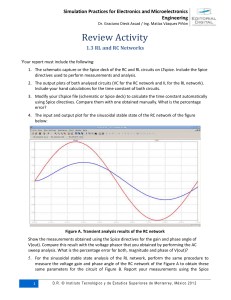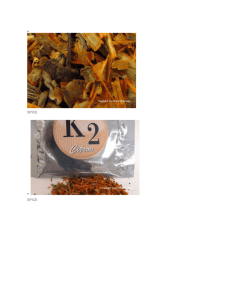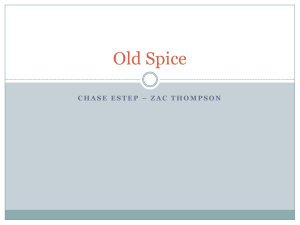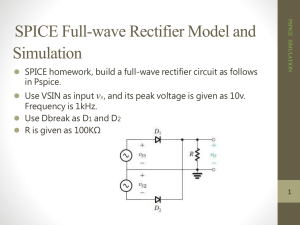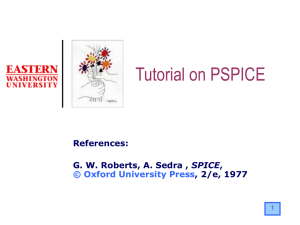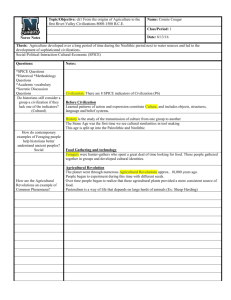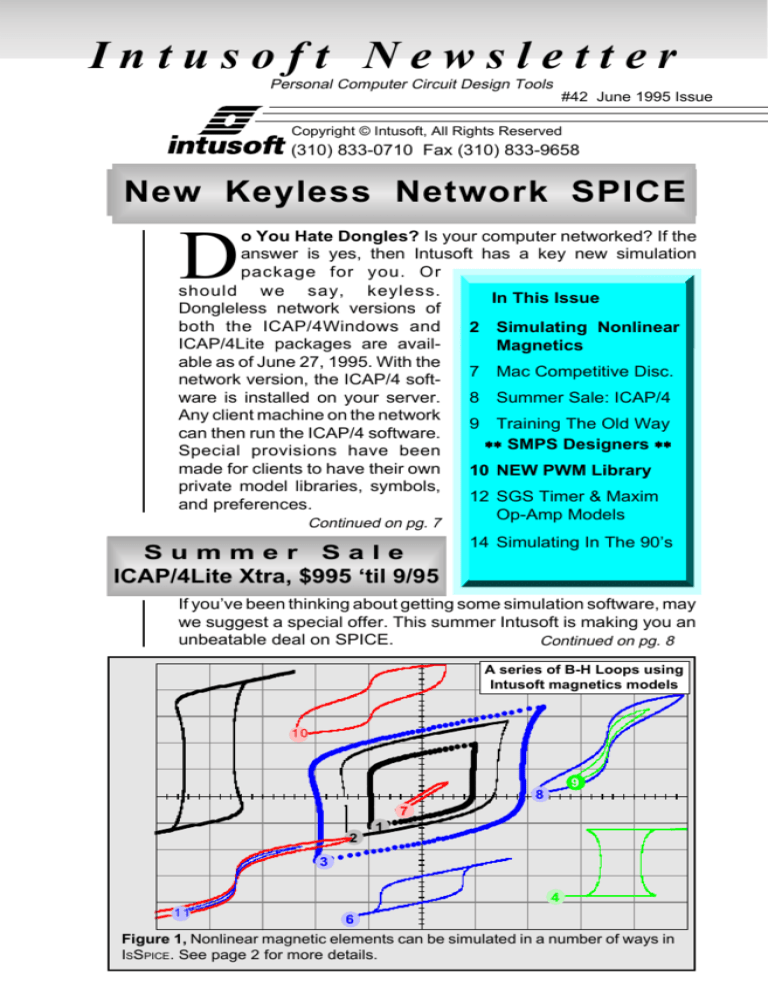
Intusoft Newsletter
Personal Computer Circuit Design Tools
#42 June 1995 Issue
Copyright © Intusoft, All Rights Reserved
(310) 833-0710 Fax (310) 833-9658
New Keyless Network SPICE
o You Hate Dongles? Is your computer networked? If the
answer is yes, then Intusoft has a key new simulation
package for you. Or
should we say, keyless.
In This Issue
Dongleless network versions of
both the ICAP/4Windows and
2 Simulating Nonlinear
ICAP/4Lite packages are availMagnetics
able as of June 27, 1995. With the
7 Mac Competitive Disc.
network version, the ICAP/4 soft8 Summer Sale: ICAP/4
ware is installed on your server.
Any client machine on the network
9 Training The Old Way
can then run the ICAP/4 software.
∗∗ SMPS Designers ∗∗
Special provisions have been
made for clients to have their own
10 NEW PWM Library
private model libraries, symbols,
12 SGS Timer & Maxim
and preferences.
Op-Amp Models
D
Continued on pg. 7
Summer Sale
ICAP/4Lite Xtra, $995 ‘til 9/95
14 Simulating In The 90’s
If you’ve been thinking about getting some simulation software, may
we suggest a special offer. This summer Intusoft is making you an
unbeatable deal on SPICE.
Continued on pg. 8
A series of B-H Loops using
Intusoft magnetics models
10
9
8
7
2
1
3
4
11
6
Figure 1, Nonlinear magnetic elements can be simulated in a number of ways in
ISSPICE. See page 2 for more details.
Page 1
Modeling Nonlinear Magnetics
Many models for magnetic cores exist [1]. Some have been
added to SPICE as built-in models while others use a subcircuit
approach. In terms of modeling, however, its important to
understand what SPICE behavioral modeling can offer vs.
direct coding methods in order to determine at what point an
AHDL implementation is appropriate. Behavioral constructs in
SPICE today are plentiful and powerful. As an example, let’s
take a look at two subcircuit based magnetic core models that
use SPICE 2G and SPICE 3 behavioral modeling.
A saturable reactor is a magnetic circuit element consisting of
a single coil wound around a magnetic core. The presence of
a magnetic core drastically alters the behavior of the coil by
increasing the magnetic flux and confining most of the flux to the
core. The magnetic flux density, B, is a function of the applied
MMF, which is proportional to ampere turns. The core consists
of a number of tiny magnetic domains made up of magnetic
dipoles. These domains set up a magnetic flux that adds to or
subtracts from the flux set up by the magnetizing current. After
overcoming initial friction, the domains rotate like small DC
motors, to become aligned with the applied field. As the MMF
is increased, the domains rotate one by one until they are all in
alignment and the core saturates. Eddy currents are induced as
the flux changes, causing added loss.
Modeling the physical process performed by a saturable core
is most easily accomplished by developing an electrical analog
of the magnetic flux. This is done by integrating the voltage
across the core and then shaping the flux analog with nonlinear
elements to cause a current to flow proportional to the desired
function. Intusoft has created a SPICE 2 compatible subcircuit
model that accurately simulates nonlinear core behavior including saturation, hysteresis, and eddy current losses [2, 3].
The popular Jiles-Atherton magnetics model, used in some
SPICE programs, is based on existing ideas of domain wall
motion, including flexing and translation [4]. While a good
description of core behavior, the Jiles Atherton model is difficult
to use unless you have access to parameters like the pinning
energy per volume, thermal energy, interdomain coupling, and
domain flexing value. Invariably, the model can only be constructed by trial simulations and tweaking of the model
parameters; if you know how. In contrast, the Intusoft model is
much easier to use and accepts commonly available electrical
or physical data sheet parameters.
Page 2
2
INTEGRATION
G1
IH2
5
3
6
RS
VM
E1
C1
RB
DH2
V VS. I
SHAPING
2
VS1
DS1
DH1
F1
IH1
VS2
1
.SUBCKT CORE 1 2 3
DH1 1 9 DHYST
DH2 2 9 DHYST
IH1 9 1 {IHYST}
IH2 9 2 {IHYST}
F1 1 2 VM 1
G1 2 3 1 2 1
E1 4 2 3 2 1
VM 4 5
C1 3 2 {SVSEC/250} IC={IVSEC/SVSEC∗250}
RB 5 2 {LMAG∗250/SVSEC}
RS 5 6 {LSAT∗250/SVSEC}
VP 7 2 250
D1 6 7 DCLAMP
VN 2 8 250
D2 8 6 DCLAMP
E2 10 0 3 2 {SVSEC/250}
.MODEL DHYST D
.MODEL DCLAMP D(CJO={3∗SVSEC/(250∗REDDY)}
+ VJ=25)
.ENDS
2
DS2
10
E2
3
2
3
X1
CORE
V(9)
FLUX
0
Figure 2, The modified Intusoft
saturable reactor model and
netlist. The SPICENET symbol below the schematic reveals the
core’s connectivity and subcircuit
flux test point.
SVSEC Volt-sec at Saturation = BSAT • AE • N
IVSEC Volt-sec Initial Condition = B • AE • N
LMAG Unsaturated Inductance = µO µR • N2 • AE / LM
LSAT Saturated Inductance = µO • N2 • AE / LM
IHYST Magnetizing I @ 0 Flux = H • LM / N
REDDY Eddy Current Loss Resistance
Table 1, Description of
the model parameters for
the modified Intusoft
saturable core subcircuit
shown in Figure 1.
Svsec and Ivsec are based on peak flux values. Lmag: For an ungapped core, L =
LM , (total path around core), For a gapped core, µR = 1, L = gap length. AE = core area,
m2, Lsat: Use core dimensions but with µR = 1, Reddy: Equals Lmag reactance when
permeability vs freq. is 3dB down.
The original Intusoft model had one shortcoming; it did not
include low frequency hysteresis. A modified version, shown in
Figure 2, solves this with the addition of 4 elements to the input.
Magnetizing current associated with low frequency hysteresis
is provided by current sinks IH1/IH2. With no voltage across
terminals 1 and 2, these currents circulate through their respective diodes, and the net terminal current is zero. When voltage
is applied, the appropriate diode starts to block and its current
sink becomes active [3]. The model takes into account frequency dependent losses associated with eddy currents and
transient widening of the B-H loop (Figure 1, Table 1) caused
by magnetic domain angular momentum. It provides excellent
results for most applications, including magnetic amplifiers.
Simulating Nonlinear Inductors
The Magnetics molypermalloy powder (MPP) core is widely
used in power conversion circuits. These cores are ideal for use
Page 3
V/%µ
Figure 3, Schematic of a
nonlinear inductor model
using SPICE 3 behavioral
elements.
7
G1
1
B3 V= V(4,3)/(V(6,2)+.02)
9
Integration
R1 .04
1
4
3
V1
DCR
8
2
R2
1.19M
Core
Loss
5
G2
1
C1
15.4U
6
B1
H
B2
%µ
B1 V= ABS(1.256*21*I(V1)/4.11)
B2 V= (1.77*E^-(60*V(5)*.0002))-(.77*E^-(60*V(5)*.00052))
in power inductors and for flyback power transformers. The
cores are available in several types. The most popular are
currently the 55xxx and 58xxx series. The 55xxx series has a
maximum flux density of 7000 gauss and the 58xxx series has
a maximum flux density of 15000 gauss, both of which are
significantly higher than ferrite. Core loss of both materials are
significantly higher than ferrite, and the 58xxx material has a
much greater core loss than the 55xxx series.
The MPP material provides a fairly “soft” B-H loop which is ideal
for applications where it is desirable to create a swinging
inductance that allows a significant decrease in inductance as
a function of the inductor current. This can be beneficial in
applications where optimum transient response is required or
to minimize the preload current of a switching power supply.
For the model to be useful, it must correctly represent the initial
inductance, the incremental inductance, which represents the
inductance under a DC biased condition, and the core loss.
.SUBCKT MP55135 1 2 10 {N=1 DCR=.01 IC=0}
R1 1 4 {DCR}
V1 3 2
G2 4 3 8 2 1
G1 2 8 7 2 1
C1 8 9 {N^2*62*1n} IC={IC} ; {} = N^2*AL = L
R2 9 2 {48.2M*300^1.451/(62.*N^2)}
B1 5 2 V=ABS(1.256*{N}*I(V1)/0.817) ; 1.256 * NI/L, .817=LM
B2 6 2 V=(1.77*E^-(300*V(5,2)*.0002))-(.77*E^-(300*V(5,2)*.00052))
B3 7 2 V=V(4,3)/(V(6,2)+.02) ; 300 in B2 is the U(avg. permeability)
B4 10 0 V=V(6,2)*{N^2*62*1n} ; Inductance Test Point
.ENDS
Figure 4, SPICE 3 subcircuit listing for the nonlinear inductor model. N is the number
of turns, DCR is the series resistance, and IC is an optional initial condition. The
models uses the mathematical equation feature of SPICE 3.
Page 4
Figure 5,
In rush
current for
an inductor
and the
MPP
58121 and
55121
cores from
Magnetics.
58121
Generic
55121
Figure 3 shows the core subcircuit while Figure 4 shows a
sample netlist and key core parameters.
Initial Inductance, DC Bias, Core Loss, & Model Operation
The initial inductance is simplified by a core parameter, AL
(inductance/1000 turns). The inductance in microhenries is
simply computed as N2 ∗ AL. The DC bias inductance and
frequency response are provided by the manufacturer in the
form of graphs for each permeability available in each of the
MPP materials. Using linear least squares, and some trial and
error, a continuous function (difference of two exponentials)
was derived which correctly calculates the % of initial permeability as a function of the DC bias in Oersteds and the initial
permeability Ui. A continuous function was also derived for the
loss as a function of the initial permeability Ui.
For 55xxx material: %Ui = 1.77e-0.0002µH - 0.77e-0.005µH
For 58xxx material: %Ui = 1.25e-0.0001µH - 0.25e-0.005µH.
55xxx material: f = 3.3E9∗e-1.451, 58xxx material: f = 3.3E8∗e-1.09.
V1 senses the current through the inductor. B1 uses this current
to calculate the magnetizing force of the inductor in Oersteds.
The magnetizing force is used by B2 to calculate the percentage of initial inductance. G1 along with C1 (=N2 ∗ AL=L) and B3
perform an integration whose result is passed to G2. G2
generates the inductor current. R2 adds a zero at the -3dB
frequency of the MPP material to model the core loss.
Example - Inrush Current
A simple circuit was created to compare the results of a generic
inductor and the Magnetics 55xxx and 58xxx models. The
results of the simulation, in Figure 5, show that the inrush
current is 25% greater with a 58121 MPP core versus the
generic inductor model and 50% greater with a 55121 MPP
core. In many applications this could cause concern over
additional stress on the capacitors, long term reliability degra-
Page 5
51.7
Tran
COLL1
8
V(8)
COLL1
4.78
-3.24
Tran
I(V3)
0
time
0
time
100.0U
NP1
-2.81
0
I(V3)
time
7.40
100.0U
Tran
13
5
BASE2
R7 .1
-6.74
100.0U
NP2
17
11
V(17) VOUT
9
Q1
QN5886
3
12
C2
10P
Tran
VOUT
NS3
4
R4
8MEG
R1 75
-3.36K
0
1.11
2
Tran
VF
R3 1000
-6.60
NS2
V(7)
VF
7
4
6
time
100.0U
0
time
100.0U
Tran
IB
-74.3M
9
X2
TURNS
NP1
1
MPP
Core
V(1)
IN
X3
TURNS
0
97.2M
I(V4)
IB
V(4)
2PRI
7
V(7)
OUT
time
100.0U
R6
200MEG
NS1
D3 DN5811
3.36K
1
V(4) BASE2
NP2
1
Figure 6, A
royer
oscillator
using the
MPP core
model.
dation, relay contacts and connector pins which could be
damaged by these currents. Similar results can be seen in
characteristics such as output
ripple and EMI filter attenuation.
X6
TURNS
5
NS3
As a typical example, the MPP
core was used in a Royer oscillaTest tor circuit shown in Figure 6. The
Point
transformer posed an interesting
simulation challenge. The resulting structure, created from
Figure 7, Transformer topology and
individual transformers [2], is
symbol used in the Royer oscillator circuit.
shown in Fig 7.
(Core and Inductance test point
2
X4
TURNS
NS1
X5
TURNS
V(2)
BDRIVE
NS2
2
Many engineers have asked Intusoft technical support if SPICE
can support nonlinear magnetics. The preceding work should
give the user a good indication of some of what SPICE and
behavioral modeling techniques can accomplish.
Thanks to Steve Sandler, Analytical Engineering Services (602)
917-9727 for his contributions to this article and for the creation of
the nonlinear inductor model.
References
[1] Survey of Magnetic Core Models, Peter Lauritzen, Margarita
Takach, APEC Conference Proceedings 1995
[2] “Improved Spice model simulates transformer’s physical processes”, L.G. Meares, Charles E Hymowitz, EDN, August 19, 1993
[3] “An Electrical Circuit Model for magnetic Cores”, Lloyd Dixon,
Unitrode Corp., Oct 1994
[4] “Theory of ferromagnetic hysteresis”, D.C. Jiles and D.L. Atherton,
Journal of Magnetism and Magnetic Materials, 1986
Page 6
New Keyless Network Version
Continued
from pg. 1
The software is licensed for a specific number of copies that
“float” on your network (Windows or Novell). This can save your
department a great deal of money since individual copies do not
have to be installed on specific machines. And network simulation performance is as good as that of stand-alone versions.
Do You Hate Dongles? - If you hate having a protection key on
the back of your computer, then the ICAP/4 network version is
for you. A protection key IS NOT REQUIRED. A key isn’t even
required on the server!* This makes Intusoft the ONLY CAE
vendor delivering SPICE 3 without a key!!
ICAP/4 owners can update their current systems. The price of
the network version is equal to the maximum number of copies
that you want to be able to run at any one time, plus 1, times the
cost of a single system (N+1 ∗ List Price). Thus, a 3 user license
is four times the single license price. Contact Intusoft or your
local dealer for further pricing and information.
* May not be available in some countries.
Mac Users... Competitive Discount!
Has the vendor of your Macintosh SPICE software recently abandoned you? Some vendors may have decided to stop selling
Macintosh software, but not Intusoft. So if you’re using a product
that’s now unsupported Intusoft would like to make you a special
offer. For current owners of PSpice® for the Macintosh* you can
take advantage of a 20% discount when you order an ICAP
package for the Macintosh. But don’t wait too long. This offer is valid
only for a limited time (until August 4, 1995).
All ICAP systems come with integrated schematic entry. You don’t
have to enter netlists by hand. Intusoft also offers compatibility with
PSpice specific syntax. Generally, models and circuits may be run
as is. In any case, Intusoft offers FREE PSpice model translation
and assistance on adapting your existing circuit simulations. With
the native code version, ICAP/4PM, Intusoft supports ALL Macintosh platforms including the Power Macintosh!
Prices and Limited Time Offer
Due to added support and development costs associated with the
Macintosh and Power Macintosh line of computers, the price of
Macintosh products will be going up August 4, 1995. So now is the
time to purchase simulation tools and support that will last you for
years to come.
*Offer does not extend to evaluation, student, or demo versions. Other competitive products of equal or greater value may also qualify. Contact Intusoft or your
local dealer for more information. Product serial # and a photocopy of distribution
disk #1 must accompany order. Offer good until 8/4/95.
Microsim is a trademark and Pspice is a registered trademark of Microsim Corp.
Page 7
ICAP/4Lite Xtra: Summer Sale
Continued
from pg. 1
The new ICAP/4Lite Xtra includes ICAP/4Lite, the INTUSCOPE
and Model Library Lite upgrades, plus the vendor IC libraries
(total value > $1680) for a single low price of $995 until 9/95.
ICAP/4Lite Xtra gives you more power than any other system
at double its price! And unlike the competition, you can upgrade
to the full ICAP/4Windows system for the price difference.
ICAP/4Lite, ICAP/4Lite Xtra, and ICAP/4Windows are available in node locked or keyless network versions*. ICAP/4Lite
owners can update their current systems to ICAP/4Lite Xtra for
the price difference, $400. Please contact Intusoft or your local
dealer for further pricing and information. Available Now!
Table 2, ICAP/4Lite Xtra represents a great opportunity to obtain
a price-performance combination that’s hard to beat.
Simulation Environment
• Unlimited Circuit Size
• AC, DC, Transient, Temperature and Parametric analyses
• Digital simulation using Boolean expressions and exact transistor gates
• Mixed Technology Simulations (physical, mechanical, non-electrical)
• Interactive analyses and parameter sweeping with ICL Scripts
• Real time waveform display of ALL voltages, currents, & power dissipations
• Advanced SPICE 3F Convergence Algorithms
Elements and Models
• SPICE 2G & SPICE 3F (Behavioral, Scripts, Breakpoints) elements
• Library Size (Analog parts) >4500, (Digital parts) >175
• Includes all standard parts and Japanese & European models, plus
nonlinear magnetics, SCRs, IGBTs, PWMs (state space), MOVs,
Mechanical elements, Lamps, Fuses, Thermistors, Pressure Sensors,
Photo/Laser Diodes and more, plus over 1300 IC/Op-amp models
• Behavioral Modeling: Math expressions, If-Then-Else, Table models
• Special Signal Generator Library
Graphics and Post Processing
• Integrated schematic entry program
• Operating point voltage display directly on the schematic
• Simulates directly from schematic with dialog setup
• Full INTUSCOPE (Graphical Waveform Processing & Analysis) Power
• Multiple windows and Curve Families with independent scaling
• Schematic compatibility with full version and across operating systems
General
• Network version with NO Protection Dongle available* (key required for
stand-alone version only)
• FREE bimonthly newsletter & modeling service for registered customers
• 30 day money back guarantee & Low Cost Upgrade Path
*May not be available in some countries
Page 8
Training The Old Fashioned Way
Questions To Ponder: Why has Microsim™ hired RCG Research (an independent consulting firm) to hold training classes
for PSpice®? Why doesn’t Microsim offer its own training?
Answer: Well, there are many possible explanations. But it
should tell you something important. At Intusoft, at least,
customer support doesn’t end with your software purchase.
Intusoft has offered SPICE training classes for over 8 years.
Our classes have been held at conventions, like Wescon and
Electro, at institutions like UCLA and DeVry, and at companies
like McDonnell Douglas and Philips. Over 400 students have
benefited from our classes not to mention thousands who have
learned simulation with our popular SPICE reference books.
Why does Intusoft offer training and other vendors don’t?
Because at Intusoft we’re engineers like you. We just happen
to know SPICE inside and out and care enough to want to
impart that knowledge to you! While not everyone takes the
training class, every Intusoft user benefits from the experience
we gain in giving the class, and the personal feedback we
receive, through SUPERIOR documentation and technical
support.
The Intusoft training class is customized and includes no more
than 6-8 people. This makes it possible to concentrate on your
personal simulation problems. So, if you need the combination
of a solid SPICE simulator and a company committed and able
to support you, then maybe its time you checked out Intusoft.
Abbreviated Intusoft Training Seminar Schedule
Morning
SPICE History, SPICE 2 and SPICE 3 Syntax
Interactive vs Batch Simulation
Hands-On Example Simulation: RLC circuit
Schematic Entry and Data Post Processing
Hands-On Example: Common Class problem chosen from a list
How To Effectively Simulate; Convergence and Problem solving
Afternoon
Basics of Semiconductor Modeling; Modeling a Diode
Subcircuit Macromodeling with Targeted Examples
Hands-On Example Simulation: Personal design problem
Mixed Mode (Analog-Digital) Simulation
Evaluating Vendor Models; How to spot a bad model
Monte Carlo Analysis or AHDL C code Modeling
Additional Example Simulations if time permits
Page 9
New Library Powers SMPS Designers
Intusoft has introduced a new SPICE model library for power
supply designers. It is the first SPICE library to contain a
comprehensive set of nonlinear switching level models for
popular Pulse Width Modulation (PWM) ICs. The new library
represents a major breakthrough for SMPS designers.
Previous models were based almost exclusively on state space
average models which don’t show many important nonlinear
effects such as propagation delay, switching speed,
component stress, sampling effects, and the total performance
capability of the IC. The library does include a unique “unified”
state space PWM model which works for AC, DC, and transient
analyses in both continuous and discontinuous modes.
However, the switching level models give designers a
capability they have never had before; the ability to plug in a
model, representative of the actual IC, and simulate the
switching performance accurately and realistically. The library
has over 400 models including:
• Over 20 voltage and current-mode PWM IC models with full
switching accuracy; Unitrode (UC1842/3/4/5, UC1524/5/7 and
UC1823/5), Linear Technology (LT1242/3/4/5), Siliconix (Si9145),
and Cherry Semiconductor (CS322/324).
• ‘Unified’ state space model for forward, buck, boost, and flyback
converter topologies and for several PWM ICs
• Nonlinear Magnetic Cores; Magnetics MPP cores, F material, R
material, and several European cores
• Transformers; a variety of structures (pulse, auto, multiple
windings, multiple cores)
• Voltage regulators; TL431, LM136
• Mosfet/IGBT Drivers; Teledyne TC426/7/8, Intl. Rectifier IR2110
• Motor controller IC; UC1637
• Power factor correction IC; UC1854
Some PWM IC models have multiple levels of complexity. This
allows the engineer to select the appropriate model features of
interest and thus control the simulation efficiency. The models
utilize analog behavioral elements and special Boolean logic
elements unique to Intusoft’s ISSPICE4. Together they greatly
reduce the model’s simulation runtime, an important factor in
SMPS analysis.
The price of the Power Supply Designer’s Library is $395.
The library will be available JUNE 26, 1995. The models are
compatible with ISSPICE3 and ISSPICE4, as well as ICAP/4
systems on DOS, NEC, Windows, Macintosh and the Power
Macintosh. ICAP/4Lite and ICAP/4Lite Xtra systems must have
the ISSPICE4 upgrade in order to run the new models.
Page 10
33.7
Tran
V(30)
-2.03
1.20M
37.6
Tran
V(30)
1.20M
575M
1.20M
time 1.23M
R5 100
2.83
C4
680P
966M
1.20M
time 1.23M
R3
10
1.50M
time
1.50M
5.02
Tran
VOUT
4.99
1.20M
R1
.01
time 1.23M
R2
.5
time 1.23M
V(7)
VDS
V(14)
COMP
COMP
REF
FDBK
C8
.01U
VC
IS
OUT
RT/CT
GND
V(12)
VREF
V(16)
VCC
V(11)
VGATE
Figure 8, Forward
converter simulation
using the new
Unitrode UC1843
PWM model and
Magnetics
MPP58121 core.
V(16)
VCC
V4
X16
PULSE
IRFF431
X13
UC1843
R11
10K
C3
4700P
R9 2.5K
V(12)
VREF
3.07
R13 1K
Q1 QN2222A
-5.23M
R10 Tran
2.5K
I(VCC)
-201M
3.04
1.20M
V(5)
VOUT
X10
MP58121
C2
400U
D2
SSR8045
time
5.26
Tran
V(5)
-65.6M
V(41)
INDUCT
D1 SSR8045
D3
DN4150
V(13)
RTCT
Tran
COMP
R8
4.7
V1 40
V(15)
ISENSE
Tran
ISENSE
-27.3M
Tran
RTCT
C7 4700P
-2.17
9.09U
Tran
INDUCT
6.23U
V(30)
time 1.23M
0
6-7-95
18:18:1
0
Waveforms with loose
(K=.99) and tight
(K=.9995) transformer
coupling. Note the
increased ringing with
loose coupling (top).
time 1.23M
1.20M
time 1.23M
R12 47K
C9 .047U
Forward Converter Using the UC1843
Figure 8 shows a forward converter example using the Unitrode
UC1843 and Magnetics MPP58121 nonlinear core models
from the new library. The PWM can be simulated with or without
the output drivers fully modeled. The IRFF431 can be replaced
with a non-ideal switch. These changes provide useful results
(see VOUT & V(41), 0 -1.5Ms) in a simulation time of 208s on
a Digital Alpha 190. With the full models in place we can further
examine the operating current into VCC, under voltage lockout
threshold, the propagation delay through the PWM, or in this
case, the detailed Mosfet performance (Fig. 9) and drive
capability of the PWM. These are the types of quantities that
can’t be measured with state space models. The steady state
switching waveforms for the PWM are shown above along with
the VOUT ripple (20mVp-p). Note the test point in the MPP
model showing the inductance variation during the simulation.
80.00
16.00
40.00
12.00
0
ID in Amps
VDS in Volts
Figure 9,
Detailed
switching
waveforms
(VDS and
ID) for the
IRFF431
are
revealed
when the
full UC1843
model is
2
used.
2
8.000
4.000
-40.00
0
-80.00
1
1
1.211M
1.212M
Page 11
1.213M
TIME in Secs
1.214M
1.215M
T h e I n t u s o ft
Mo d e l i n g C o r n e r
In this edition of the modeling corner we present circuits using
models from SGS-Thomson and Maxim; a timer circuit using
a 555 type IC and a window (voltage) detector using a dual
comparator. The Intusoft Newsletter subscription disk contains
the new timer models, 24 op-amp and comparator models from
Maxim, plus a new TL431 voltage reference model developed
by Intusoft Tech Support. A new library for the popular Little
Foot™ and Lite Foot™ DMOS and Trench-Gated MOSFETS
from Siliconix is also included (thanks go to John Huang and
Richard Williams @ Siliconix).
New 555 Timers From SGS-Thomson
SGS-Thomsom has released models for their TS555 and
TS556 timers [1]. It features two extra terminals (9 and 10,
adjust and initialization) which are used to improve the convergence and accuracy. To use the model, a capacitor must be
inserted between these pins (see [1] for more information). In
the monostable mode, the capacitance value varies from 1pF
(1us period) to 100pF (100ms period). In the astable mode, the
capacitor value ranges from 1pF (0.1us period) to 500nF (10ms
period). In tests of the model, we found that the capacitance
value was not critical, but the astable mode was more stable
when Gear integration (.OPTION Method=Gear) was employed. Pin 9 is also used to initialize the model. It is set to an
initial voltage of zero using a .IC statement (.IC V(9)=0).
.SUBCKT TS555M 1 2 3 4 5 6 7 8 9 10
* 1 V-, 2 Trigger, 3 Out, 4 Reset, 5 Crtl Voltage,
5.25
Tran
* 6 Threshold, 7 Discharge 8 V+, 9 Adj & Init, 10 Adj
RESET
.MODEL MPJR PMOS VTO=0.0 TOX=90E-09 KP=2.0E-02 LEVEL=3
-250M
0
time
10.00M
.MODEL MNJR NMOS VTO=0.0 TOX=90E-09 KP=2.0E-02 LEVEL=3
.MODEL MNDIS NMOS VTO=1.0 TOX=80E-09 KP=2.0E-02 LEVEL=3
5.36
Tran
.MODEL MDTH D N=0.7 IS=1E-08
OUTPUT
RAA 8 5 1E+5
R1 10K
-436M
0
time
10.00M
RBB 5 27 1E+5
RCC 27 1 1E+5
V(1)
IALIM 8 1 94E-06
VCC
RESET
V(3)
RESET
OUT
EALIM 24 1 8 1 1
OUTPUT
DISCHG
C2
V1
E1H 24 41 24 4 1 ;COMPA 1
0.01U
R2
5
CTRL
100K
D1H 32 41 MDTH
THRES
D1B 1 32 MDTH
V2
ADJ&INIT
I1 6 1 10P
PULSE
C1
TRIGGER
500N
G1 1 32 5 6 6E-07
ADJUST
VEE
E2H 24 42 24 4 1 ;COMPA 2
D2H 22 42 MDTH
C4
D2B 1 22 MDTH
.01U
Figure 10, Astable timer
I2 2 1 10P
simulation using the new
G2 1 22 27 2 6E-07 ;RS
MPH 31 32 24 24 MPJR W=50U L=6U
ROUT 15 3 100
SGS-Thomson models.
MNB 31 22 1 1 MNJR W=100U L=6U
RCHOUT 3 1 1E+12
MP1 9 31 24 24 MPJR W=42U L=6U
EMI 10 1 24 1 0.5
MN1 9 31 1 1 MNJR W=26U L=6U
EGRILLE 11 1 24 9 1
MP2 31 9 24 24 MPJR W=10U L=37U
MDIS 13 11 1 1 MNDIS W=45OOU L=6U
MN2 31 9 1 1 MNJR W=9U
L=40U
RDIS 13 7 20
RRST 4 1 1E+12 ;RESET
RCHDIS 7 1 1E+12
EOUT 15 1 9 1 1 ; OUTPUT STAGE
.ENDS
Page 12
B1
V= V(5) + V(14) + V(4)
V(15)
VIN
Tran
VIN
5.77
4.33
V(5)
VSURGE
V(14)
V60
0
time
100.0M
B1 sums the 60Hz,
120Hz, and Vsurge (piece
wise linear noise source)
voltages to create VIN
V1
5
R3
1MEG
R6
5K
V(2)
VUNDER
InA+
V+
VCC
OutA
R2
62.2K
R5 10K
Hyst
X3
SN7401
Ref
OutB
InB-
V(4)
V120
X2
MAX923
R1
294K
GND
V-
R4
2.4MEG
V(1)
VPOWER
V(3)
VOVER
Tran
VPOWER
5.25
-224M
0
time
100.0M
Figure 11, Maxim’s new release includes over 24 new op-amp and comparator
models. The MAX923 ultra-low power dual comparator (with hysterisis and a
built in voltage reference) is used here to create a voltage window detector.
Several typographical errors were noted in the original model
[1], as well as cases where the model did not match the vendors’
block diagram. Intusoft has corrected these errors and tested
the models. The corrected subcircuit netlist for the timer model
is shown in Figure 10 along with a typical astable simulation. If,
in the course of running the models as listed in [1], you
encounter any problems, please feel free to contact Intusoft
technical support. You can also get a copy of the June newsletter floppy which has the tested listings.
New Maxim Op-amps and Comparators
Maxim has provided Intusoft with an addition to their SPICE
model offerings. Models are included for op-amps (MAX427 ,
473, 478, and 492 families), transconductance amps (MAX435
family) and comparators (MAX921, 922, 923, 924, and 941
families). We chose the MAX923 (low power, low cost comparator) for a simple but illustrative example. Figure 11 shows
an undervoltage/overvoltage window detector with its Power
OK, under, and over voltage outputs. The design procedure is
outlined in [2]. Of particular simulation interest is how the VIN
waveform was constructed. VIN is the summation of 3 separate
sources. The summing is performed by the ISSPICE4 B element
(B1), which allows mathematical expressions containing voltages and currents from anywhere in the circuit. Many kinds of
stimulus waveforms can easily be created in this manner [3].
[1] Standard Linear Circuits Macromodels, SGS-Thomson Microelectronics, 6/94
[2] Maxim 1995 New Releases Data Book Vol. IV pg. 3-57“
[3] Stimulating Circuits: Test Generators, Intusoft Newsletter, November 1994.
Page 13
Simulating In The 90’s
Running SPICE is no longer the same as it was when the
program was first introduced. Schematic entry has replaced
card decks, interactive simulations that now take only seconds
have replaced day long mainframe runs, and real time graphical
data processing has replaced crude line printer plots. This is the
state of simulation today. Changes brought about by new
software products, such as ICAP/4 , have had a profound effect
on how engineers simulate circuits.
ICAP/4 is an integrated simulation system that includes 4
modules, each one performing a different function.
•
SPICENET
Integrated Schematic Entry
•
MODELS
SPICE & HDL Model Libraries
•
ISSPICE
Native Analog Mixed Mode Simulation
•
INTUSCOPE
Data Processing and Analysis
With ICAP/4 you can cut through the toughest circuit design
problems with ease, create better products with more functions
and higher yields, and explore new concepts. From power to RF
to mixed mode, ICAPS allows you to analyze and predict the
performance of all types of circuits.
Intusoft has been a leader in full featured design tools since our
first product, ISSPICE, was released over ten years ago. Our
family of software, integrated under the ICAP/4 environment,
reduces engineering and manufacturing costs, increases
yields, and slashes repair, testing, and design time. The following sections contain detailed information about the ICAP/4
system. They will assist you in discovering the power of ICAPS.
SPICENET: Integrated Schematic Entry
Description: SPICENET is a schematic entry program that is
designed to be an interactive front-end to ISSPICE4. It greatly eases
the burden of creating a SPICE netlist by generating a complete
netlist, ready for simulation, directly from the schematic. Unlike
other schematic packages, which are geared for digital circuits or
PCB layout, SPICENET supports all facets of SPICE. SPICENET
alleviates the editing and syntax headaches allowing you to spend
your time creating a better design instead of debugging typos.
Benefits: Schematic entry with SPICENET is designed to be faster
than pencil and paper. Most components can be placed on the
schematic with a single keystroke. And with all its functions on pull
Page 14
down menus, you can input
and simulate your first design
in less than an hour. SPICENET
has a direct interface to ISSPICE4 allowing waveforms to
be interactively cross-probed
directly on the schematic. Additionally, the circuit operating
point voltages can be updated
as component values are
changed.
Schematic Entry Features
•
•
•
•
•
•
•
•
•
•
•
•
•
•
Produces a complete SPICE netlist, no editing necessary
Runs a simulation directly from the schematic
Interactively cross-probe waveforms by clicking on a node or device
Change values and resimulate directly from the schematic
Place parts by part number or from a list
A Preferred Parts Menu can be defined by the user
On-line symbol editor plus pre-made symbols for every model
Automatic subcircuit maker
Special easy to use pop-up dialogs for SPICE control statements
Compatible with any SPICE simulator
Multiple page schematics, Edit several schematics at one time
Schematics are compatible between versions and platforms
Cut and paste between different schematics
Report quality graphics: supports all Windows and Macintosh Chooser
output devices
ISSPICE: Analog/Mixed Signal Simulation
Description: The new Interactive
I S S PICE 4 program provides a
quantum leap in performance over
other SPICE simulators. It allows
you to explore circuit performance
by interactively running different
analyses and sweeping any circuit
variable. Analyses include AC,
DC, Transient, pole-zero, noise,
sensitivity, Fourier and distortion
analyses. Circuit temperature
variations are available for all
analyses and individual elements.
Benefits: The advanced features of ISSPICE4 allow all types of analog and mixed
mode applications to be simulated like: switch mode power supplies, mixed signal
ASICs, RF communication systems, interconnect problems, control systems, and
mixed domain (mechanical/physical) systems. There are several I SSPICE
versions, described next, that vary in speed, circuit size, operating system, and
built-in model/analysis support.
Page 15
•
ISSPICE4 is 32-bit version of SPICE 3F.2 for Windows, Windows
NT (x86, Mips, Alpha) and Macintoshs. It supports unlimited
size circuits, waveform cross-probing, real time waveform
display, AHDL models, simulation scripts and breakpoints, and
is a native mixed mode simulator.*
•
ISSPICE3 provides the same analysis, model, and real time
waveform support as ISSPICE4 except that it runs on DOS,
Macintosh, and Power Mac systems and is not interactive.
ISSPICE (Analog/Mixed Mode Simulator) Features
Analysis and Built-in Models (All Versions)
• Elements: Resistors, Capacitors, Inductors, Coupled Inductors,
Transmission Lines, Diodes, BJTs, JFETs, MOSFETs (Level 1,2, and 3),
Subcircuits, Independent/Dependent sources (SPICE2 polynomials)
• AC, DC, transient, noise, Fourier, distortion, temperature, DC sensitivity
• Monte Carlo Analysis: Statistical yield analysis of circuit performance
• Randomly vary circuit parameters to test performance
• Circuit Optimization/Performance Analysis: Circuits can be optimized
based on a user defined objective function.
Additional ISSPICE3/ISSPICE4 Features
• Real-time waveform display of voltages, currents and power dissipation
• Elements: GaAs Mesfets, MOSFETs Levels 4, 5, and 6, Lossy T-Lines,
voltage/current ctrl'd Switches, and Boolean logic expressions.
• Analyses: AC sensitivity and Pole-Zero analyses, Temperature variations
on individual elements
• Behavioral Modeling: In-line Equations, Table models, If-Then-Else
• Simulation Scripts: a robust scripting language that allows simulation
breakpoints and loops of different analyses to be run as a test procedure.
Additional Interactive, AHDL & Mixed Mode ISSPICE4 Features
• Interactively run analyses without having to edit the netlist or restart the
simulator, Add, delete, or rescale waveforms on the real-time display
• Native Mixed Mode: ISSPICE4 includes a 12 state digital logic simulator and
models with timing information *
• Sweep parameters one at a time or in groups with great ease
• Start, stop, pause, change, or resume any analysis on demand
• Use C code subroutines & AHDL models based on XSPICE *
• Elements: Digital logic gates, Flip-Flops, Latches, State Machine, Freq.
Div., RAM, Sampled-Data Filters, Nonlinear VCOs, Laplace Equations *
• Supports interprocess communication and control via shared memory
Compatibility
• Works with ALL popular schematic entry programs
• Accepts Berkeley SPICE 2G.6 or 3F.2 syntax; Outputs SPICE 2 and 3
Adding C Subroutines To ISSPICE4 *
The Intusoft Code Modeling Software Development Kit (CMSDK)
allows you to add your own C code subroutines to ISSPICE4. The C code
is the basis for XDL, a new HDL (Hi-level Description Language). XDL
models are like traditional SPICE models, except they are created by
you. The CMSDK is required for model development, however, any
ISSPICE4 program can then use the newly developed models.
* Windows Only
Page 16
SPICE Model Libraries
Description: ICAP/4Windows and
More Model Types Than
Macintosh include an extensive array of
Any Other Vendor
over 6000 models.
Benefits: The model libraries contain a
Parameter Passing
wide variety of models including diodes,
Model Generation From
zeners, BJTs, Darlingtons, op-amps,
Data Sheets
comparators, transformers, nonlinear
magnetics, JFETs, SCRs, IGBTs, Triacs,
power MOSFETs, PWMs, SC filters, analog behavioral models, digital logic gates,
SPICE Model Libraries
switches, opto-isolators, transmission line
models, crystals, vacuum tube models
and more. Over 100 “Generic Template” models that convert data sheet parameters into SPICE parameters are also included. Models are stored in ASCII text
files that can be viewed and edited. A complete list of models is available. Note:
The vendor supplied IC libraries (over 1300 models), the RF Device Library (over
300 models) and the Power Library (over 400 models) are available separately.
Model Generation From Data Sheets: A separate program (SPICEMOD 2.0) is
available for creating SPICE models from data sheet parameters.
INTUSCOPE: Graphical Waveform Processing
Description: I NTU S COPE is an
interactive graphical data processing
program especially designed to
display and analyze ISSPICE output
data. I NTU S COPE can display
waveforms from any Berkeley SPICE
compatible program, as well as user
generated data files.
Benefits: INTUSCOPE is more than just
a SPICE post processor. It is a very
powerful data processing system. It
displays data as waveforms and
contains a comprehensive set of waveform processing functions and operations.
Data Analysis Features
•
•
•
•
•
•
•
•
•
•
Displays all circuit voltages, currents, power dissipations and more
Accepts output from any SPICE program or user generated data files
Can save any displayed waveform for use as circuit stimulus
32-bit version allows large waveforms to be displayed and analyzed
Various scaling formats include linear, semilog, histogram, and probability
Multiple graphs with multiple independent scales
Waveform Operations: RMS, Pk-Pk, Mean, Max, Min, cursors
Add, subtract, multiply, and divide waveforms
Math Functions: trigonometric, log, power, ex, algebraic
Advanced Waveform Functions: Integrate, differentiate, FFT, polynomial
regression, filtering, gain/phase margin prop delay, rise/fall time
• Report quality output similar to SPICENET
Page 17
Additional SPICE Related Products
RF Device Library version 3.0
Description: This is a special SPICE model library for those users
performing simulations at or above 200MegHz. It contains models
for over 300 different RF devices including bipolar transistors,
FETs, MMICs, GaAs Mesfets, PIN Diodes, and RF beads.
Benefits: The RF library allows any SPICE program to simulate
high frequency circuits using linear and nonlinear AC, DC, and
Transient analyses. This capability was not available before because of the lack of quality subcircuit based models. All models are
characterized up to their published s-parameter data.
SPICE Reference Books
“SPICE APPLICATIONS HANDBOOK, 2nd Edition” - Collections of
past Intusoft Newsletters, 6/86 - 2/94 (34 in all!).
“A SPICE COOKBOOK” - Over 100 practical circuit examples encompassing a wide array of topics (RF, Power, Filters, Digital) and how
they were simulated with SPICE.
FILTERMASTER: Filter Design
Active/Passive Filter Design
Description: The F ILTER M ASTER
DESIGN SERIES is a set of PC-based
programs used for the synthesis, and
analysis of analog LC (lumped
element) and active RC filters. Lowpass, high-pass, bandpass, and
band-stop filters can be synthesized.
Available approximations include:
Elliptic (Cauer), Butterworth,
Chebyshev, Inverse Chebyshev or,
Bessel (for low-pass filters), and two
general amplitude approximations.
Active & Passive Filter Design
Benefits: The FILTERMASTER DESIGN SERIES includes both synthesis, as well as
analysis capabilities, allowing filter topologies and characteristics to be easily
compared for the optimal results. Once a filter is designed, it can be transferred
directly onto your SPICENET schematic and simulated with ISSPICE.
Synthesis and Analysis In One Package
Special Interfaces
• Interface to the SPICENET schematic entry program allowing
inclusion of designed filters directly onto your schematic.
• Direct output of subcircuit and
stand-alone SPICE netlists.
• Output of component tolerances for use with Monte Carlo
statistical yield analysis (passive only).
Page 18

